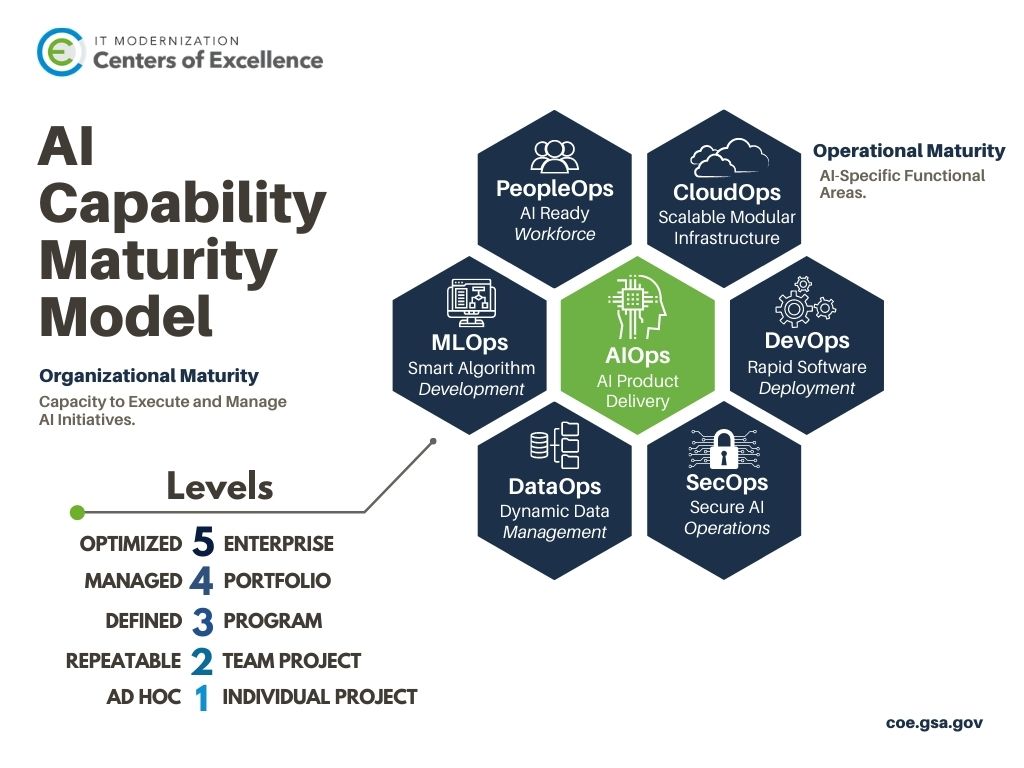How We Measure AI Readiness
By the Artificial Intelligence Center of Excellence
The GSA IT Modernization Centers of Excellence have designed the CoE AI Capability Maturity Model (AI CMM) as a planning tool for organizations building an AI investment strategy and technology roadmap. Looking at projects and programs through the AI CMM highlights milestone indicators of maturity level throughout the AI journey. These milestones link back to organizational strategy and performance objectives.
The AI CMM is a planning tool to assess the current state of an organization’s Artificial Intelligence activities. The plans generated from AI CMM activities will enable decision-makers to identify investment areas that simultaneously meet near-term goals in the acceleration of AI adoption and broader enterprise business goals.
Organizational Maturity
Organizational Maturity Areas represent the capacity to execute AI initiatives across the organization. The CoE takes two distinct approaches to organizational maturity. The first approach is influenced by the Capability Maturity Model Integration (CMMI) system of understanding organizational maturity. This particular method is especially useful when observing organizations using a top-down approach. The Top-Down View in the table below is based on CMMI levels 1-5.
In addition to leveraging the CMMI system as an industry standard for understanding organizational maturity, the CoE designed a complementary perspective on observing organizational maturity that is user-centric. This Bottom-Up view is built from observations during CoE engagements with federal agency partners, market research, case study evaluation, and lessons learned.
Senior leaders and executives will generally observe organizational maturity from a Top-Down view. The Bottom-Up view reflects the perspective of Program and Mission Managers that are focused on delivery. The CoE can analyze activities from a Top-Down, Bottom-Up, or dual-view perspective.
Operational Maturity Areas
Operational Maturity Areas represent organizational functions that impact the implementation of AI capabilities. While each area is treated as a discrete capability, they are generally dependent on one another. The Operational Maturity Areas are:
- People: Recruit, develop, retain, and organize an AI-ready workforce.
- Cloud: Provision and allocation of storage, compute, and other resources in the cloud.
- Security: Ensure secure deployment of code, access to systems and data, and identity resolution across storage, compute, and data assets.
- Development: Deploy and manage software throughout development, test, and production environments.
- Data: Maximize data discovery, access, and use throughout its lifecycle.
- ML: Test, experiment, and deploy AI or machine learning models.
- AI: Identifying and resourcing AI initiatives within the organization.
Each Operational Maturity Area above is supported by related Key Activities and Key Questions to focus the conversation on the current organizational state. To learn more about Key Activities and Key Questions, reach out to us at connectcoe@gsa.gov.
Caption: The AI Capability Model graphic shows the seven Operational Maturity Areas and five Organizational Maturity Levels
AI Readiness & Planning with the CoE
The CoE can facilitate AI readiness and planning activities with a partner agency, leveraging the AI Capability Maturity Model during a Phase 1 - Discovery engagement. Throughout the engagement, AI CoE Leads will conduct user interviews, current state research, and identify Organizational Maturity for each of the seven Operational Maturity Areas. The output of the CoE facilitated AI readiness and planning activities will be a detailed report describing the current state, a technology roadmap with key milestones, and an investment plan to meet future state objectives. The CoE will also be ready to support follow on implementation to turn those plans into executed projects.
To learn more about the AI CoE contact us or visit coe.gsa.gov. Follow us on Twitter @GSACoE to join our ongoing conversations about AI in government.
Return to Updates

